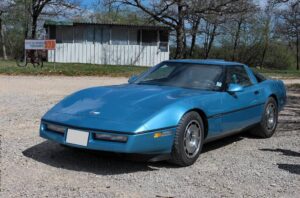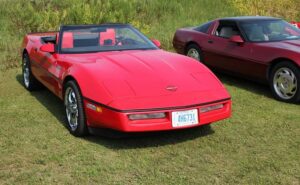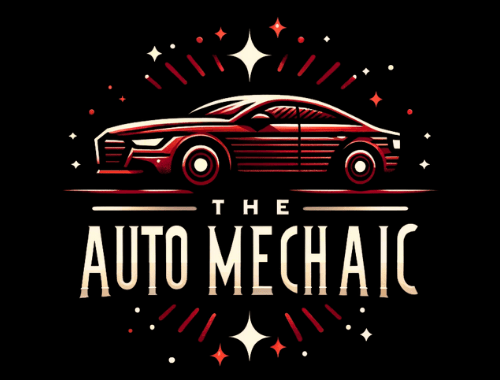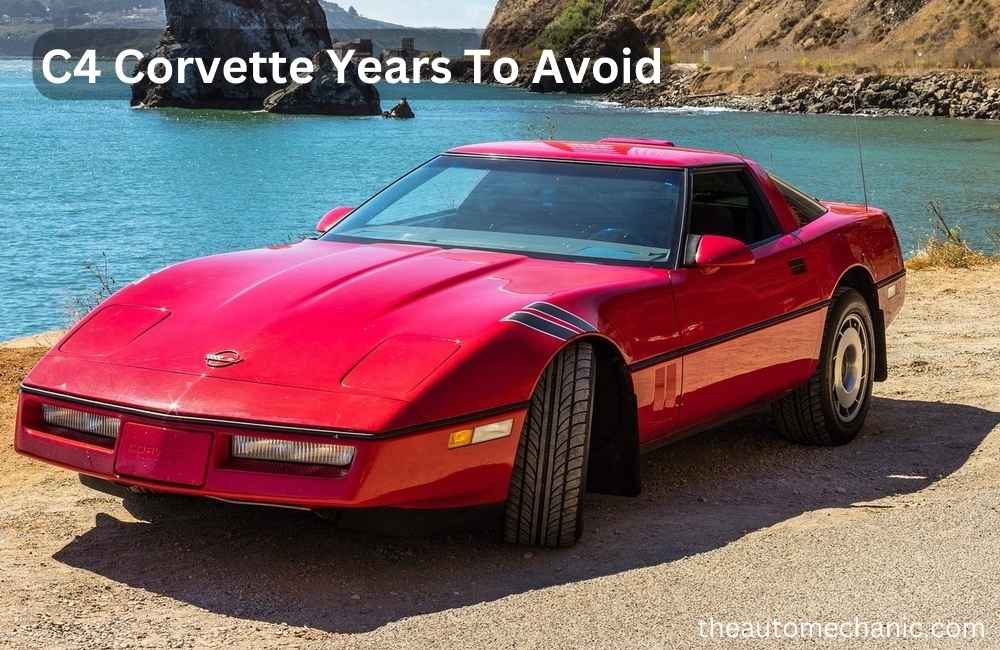The Chevrolet C4 Corvette has left an indelible mark on automotive history, known for its performance, style, and unique design. However, as with any vehicle, certain model years have garnered attention for potential challenges enthusiasts and buyers should know.
This article will explore the C4 Corvette years to avoid and the reasons behind these considerations. Whether you’re a Corvette enthusiast, a potential buyer, or simply curious about the nuances of this legendary sports car, join us as we uncover the details that can help you make informed decisions when navigating the landscape of the C4 Corvette.
What To Look For In A Chevrolet Corvette C4?
Several key areas must be scrutinized when considering a Chevrolet Corvette C4 to ensure you’re making an informed and wise investment. While known for its performance and style, this iconic sports car requires thorough evaluation to avoid pitfalls. Here’s what to look for:
- Engine Health: Inspect the engine for signs of neglect and oil or water leaks. While the base Corvette’s LT1 engine offers strong performance, check for electrical issues and ensure all components function optimally. Overheating can lead to head gasket failure, often caused by radiator blockages.
- Mechanical Components: Examine the headlights’ flip-up mechanism, as it’s prone to breakage. Inspect the wheel bearings and universal joints for any clicking or grinding noises, which may indicate age-related wear. Verify the functionality of cooling fans to prevent overheating issues.
- Chassis and Body: Check for cracks or crazing in the glass-fiber chassis, a common concern in older C4 Corvettes. Inspect for any signs of corrosion or rust, particularly in critical areas such as the frame and suspension components.
- Dashboard and Electronics: Pre-1990 models are more likely to experience dashboard problems, which can affect functionality and aesthetics. Be cautious with vehicles with LCD dashboards, as repairing or replacing them can be costly. Ensure all electronic components, including lights, gauges, and infotainment systems, are in working order.
- Tires and Wheels: Inspect the tread depth, age, and condition of the tires and wheels. Listen for any unusual noises from the wheel bearings or universal joints, which indicate wear and tear.
- Maintenance and Documentation: A comprehensive service history is invaluable. Look for a well-maintained vehicle with documentation of regular oil changes, fluid checks, and other routine services. A diligent owner who has kept records can provide confidence in the vehicle’s care.
C4 Corvette Years To Avoid-1984

The C4 Corvette, Chevrolet’s fourth-generation sports car, debuted in 1984, marking a significant departure from its predecessors. The 1984 C4 Corvette introduced a more modern and aerodynamic design, embracing the sleek lines of the 1980s. It featured a new chassis with an independent rear suspension to enhance handling and performance. Under the hood, the 1984 model initially came equipped with a Cross-Fire Injection (CFI) V8 engine, producing around 205 horsepower.
Why Avoid It?
Despite its innovative design and engineering advancements, the 1984 C4 Corvette is often considered a year to approach cautiously. The primary reason is the teething problems that afflicted this inaugural model year. Electrical issues were a notable concern, with various components prone to malfunctions. Additionally, the Cross-Fire Injection system, an attempt to meet emission standards, suffered from performance and drivability challenges, often leading to lackluster power delivery and hesitations.
These issues culminated in a less-than-ideal ownership experience for many early adopters of the C4 Corvette. While some enthusiasts have successfully addressed these problems through diligent maintenance and modifications, the 1984 model year requires more attention and effort to keep running smoothly.
C4 Corvette Years To Avoid- 1985

The C4 Corvette, Chevrolet’s fourth-generation sports car, debuted in 1984, marking a significant departure from its predecessors. The 1984 C4 Corvette introduced a more modern and aerodynamic design, embracing the sleek lines of the 1980s. It featured a new chassis with an independent rear suspension to enhance handling and performance. Under the hood, the 1984 model initially came equipped with a Cross-Fire Injection (CFI) V8 engine, producing around 205 horsepower.
Why Avoid It?
Despite its innovative design and engineering advancements, the 1984 C4 Corvette is often considered a year to approach cautiously. The primary reason is the teething problems that afflicted this inaugural model year. Electrical issues were a notable concern, with various components prone to malfunctions. Additionally, the Cross-Fire Injection system, an attempt to meet emission standards, suffered from performance and drivability challenges, often leading to lackluster power delivery and hesitations.
These issues culminated in a less-than-ideal ownership experience for many early adopters of the C4 Corvette. While some enthusiasts have successfully addressed these problems through diligent maintenance and modifications, the 1984 model year requires more attention and effort to keep running smoothly.
C4 Corvette Years To Avoid- 1986

Photo Source: Flickr
The 1986 C4 Corvette retained the sleek and modern aesthetics of its predecessors, reflecting the design trends of the era. Under the hood, the Cross-Fire Injection (CFI) V8 engine remained, balancing power and efficiency. The model year also saw the introduction of the Convertible option for the C4 Corvette, adding a new dimension to the lineup.
Why Avoid It?
Despite its improvements over previous years, the 1986 C4 Corvette has earned a degree of caution from enthusiasts due to ongoing issues related to the Cross-Fire Injection system. While efforts were made to refine the system, performance inconsistencies and potential drivability challenges persisted for some owners. Electrical problems were also reported, underscoring a pattern that affected earlier model years.
For those considering a 1986 C4 Corvette, it’s advisable to be aware of these recurring concerns and conduct thorough research before purchasing. While the 1986 model represents a step forward in the C4 Corvette’s evolution, the lingering issues related to fuel injection and electrical components may influence potential buyers’ decision-making process. As always, seeking expert advice and performing a comprehensive inspection can help mitigate potential challenges associated with this model year.
C4 Corvette Years To Avoid- 1990-1991

Photo Source: Flickr
The early 1990s saw the C4 Corvette sporting its distinctive and iconic design, blending modern aesthetics and performance-focused engineering. These years featured the transition to the L98 engine, which replaced the Cross-Fire Injection (CFI) system and offered improved power output and drivability. Technological advancements and refinements were evident throughout the vehicle, reflecting Chevrolet’s commitment to enhancing the driving experience.
Why Avoid It?
Despite the advancements, the 1990 and 1991 C4 Corvettes have garnered attention from enthusiasts due to potential issues associated with the ZR-1’s Lotus-designed engine. While capable of impressive power, this high-performance engine also introduced complexities that led to higher maintenance costs. Repairs and servicing of the ZR-1 engine can be notably more expensive compared to the standard L98 engine, which may give some potential buyers pause.
Enthusiasts considering a C4 Corvette from 1990 or 1991 should be aware of these considerations and assess their willingness to manage the potential higher maintenance costs associated with the ZR-1 engine. Thorough research, expert opinions, and diligent maintenance practices are key to ensuring a positive ownership experience for those intrigued by the allure of these model years.
C4 Corvette Years To Avoid- 1994-1995

The mid-1990s saw the C4 Corvette maintain its sleek and distinctive appearance, a hallmark of the series. These years showcased the culmination of refinements and improvements made throughout the generation. Technological enhancements were apparent, and the LT1 engine made its mark, providing a blend of power and efficiency to complement the C4’s performance-oriented character.
Why Avoid It?
Despite the advancements, the 1994 and 1995 C4 Corvettes have garnered attention due to their transitional position in the model lineup. These years marked the end of the C4 generation, as the C5 Corvette was set to debut. Consequently, the 1995 model year had a notably lower production volume, making it a rarer find. Additionally, the transition to the OBD-II system introduced complexities in diagnostics and repairs, potentially impacting servicing procedures.
While these years represent the closing chapter of the C4 era and showcase many improvements, the lower production volume and technological transitions may influence the decision-making process. Thorough research, expert guidance, and a comprehensive assessment of individual preferences are vital to making an informed choice regarding these model years.
Tips To Maintain Your Chevrolet Corvette C4
Maintaining your Chevrolet Corvette C4 is essential to ensure its longevity, performance, and continued enjoyment. This iconic sports car, known for its style and power, requires regular care and attention. Here are some valuable tips to help you keep your Corvette C4 in top condition:
- Regular Maintenance Schedule: Adhere to the manufacturer’s recommended maintenance schedule. Regular oil changes, fluid checks, and tune-ups are crucial to keep your Corvette’s engine running smoothly and efficiently.
- Fluid Checks and Changes: Regularly inspect and change fluids such as engine oil, transmission fluid, brake fluid, and coolant. Clean and fresh fluids help prevent premature wear and maintain optimal performance.
- Tire Care: Monitor tire pressure and tread depth regularly. Properly inflated tires ensure safety, handling, and fuel efficiency. Rotate and balance your tires as recommended to promote even wear.
- Brake System Maintenance: Inspect the brake system regularly, including pads, rotors, and brake lines. Properly functioning brakes are essential for safety and performance. Address any brake-related issues promptly.
- Cooling System Checks: Monitor the cooling system. Ensure the radiator is clean and free from debris to prevent overheating. Check coolant levels regularly and consider flushing the cooling system as recommended.
- Electrical Components: Inspect all electrical components, including lights, gauges, and the battery. Check for any signs of corrosion, loose connections, or malfunctioning parts. Keeping your electrical system in good condition enhances safety and convenience.
- Suspension and Steering: Inspect the suspension and steering components for wear or damage. Proper alignment and suspension maintenance contribute to a smooth ride and accurate handling.
- Exterior Care: Regularly wash and wax your Corvette to protect the paint and finish from the elements. Address any scratches or dings promptly to prevent rust formation. Protect the vehicle from direct sunlight and extreme temperatures whenever possible.
- Interior Maintenance: Clean and condition the interior regularly to prevent wear and fading. Keep the dashboard and upholstery clean to maintain a comfortable and visually appealing cabin.
- Owner’s Manual Reference: The owner’s manual contains specific maintenance guidelines and recommendations tailored to your Corvette C4 model. Following the manufacturer’s guidance helps ensure proper care.
- Professional Inspections: Schedule periodic professional inspections, especially for critical components such as the engine, transmission, and suspension. A skilled mechanic can identify potential issues before they escalate.
- Storage: If you plan to store your Corvette for an extended period, use proper storage techniques, such as a car cover and tire chocks. Consider disconnecting the battery to prevent drain.
Frequently Asked Questions
1. Which specific years of the C4 Corvette should I be cautious about?
The C4 Corvette years to approach with caution include 1984, 1985, 1986, 1990-1991, and 1994-1995.
2. What issues are commonly associated with the C4 Corvette model years to avoid?
These years, we may have experienced problems like electrical issues, performance challenges with certain engine variants, and potential issues related to specific components like the headlight mechanism, dashboard, and cooling system.
3. Are there any notable improvements in the later C4 Corvette model years?
While earlier years had issues, later C4 Corvette models addressed some of these concerns through engine performance, design, and overall reliability refinements.
4. Is mitigating the potential problems associated with these years possible?
Yes, thorough research, pre-purchase inspections, and consulting with experienced Corvette enthusiasts or mechanics can help you make an informed decision and address any existing issues.
5. Are any C4 Corvette model years generally considered more reliable?
Many enthusiasts find that C4 Corvettes from the mid-1990s (post-1995) offer improved reliability and fewer issues than those from earlier years.
6. Should I avoid purchasing a C4 Corvette from the mentioned years, or can they still be good options with proper care?
While these years have specific considerations, well-maintained examples can still provide enjoyable ownership experiences. Proper care, maintenance, and addressing potential issues can make a C4 Corvette from these years a viable choice for enthusiasts.
Final Words
The allure of the Chevrolet C4 Corvette remains undiminished. While sleek design and exhilarating performance continue to captivate, understanding the nuances of specific model years is paramount. Our exploration of the C4 Corvette years to approach with caution sheds light on potential challenges, providing a compass for those venturing on their Corvette journey.
Remember, knowledge is key, and armed with insights into these particular years, you can confidently navigate the world of C4 Corvettes. Whether you’re considering a purchase or deepening your appreciation for this classic, we hope this guide empowers you to make well-informed decisions and embrace the legacy of the C4 Corvette with open arms and a discerning eye.

Bruce William is a professional content writer and vehicle engineer with extensive car maintenance and repair knowledge. His expertise spans all vehicle parts, offering practical solutions for various automotive issues. Bruce provides valuable insights through his website articles to help readers maintain their cars for optimal performance and longevity.

